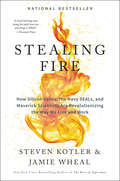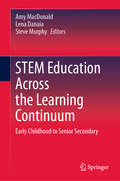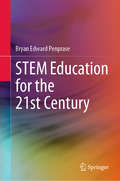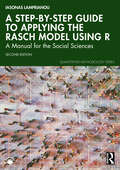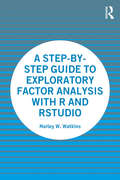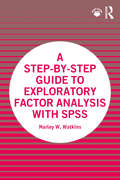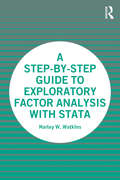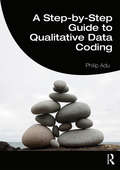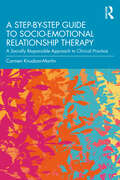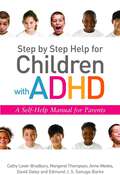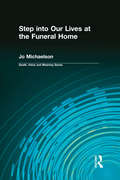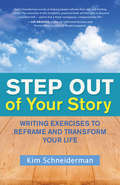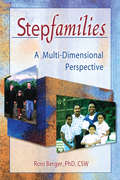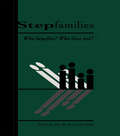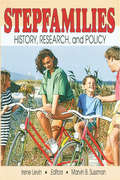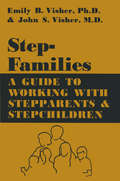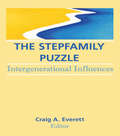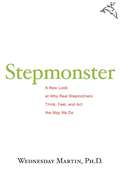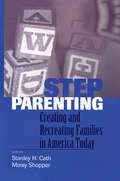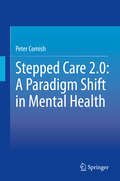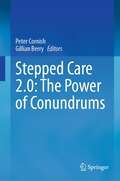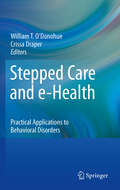- Table View
- List View
Staying Sober: A Guide for Relapse Prevention
by Terence T. Gorski Merlene MillerThis Relapse Prevention Model accepted by many rehab facilities and is a definite read for those who struggle with addictions.
Stealing Fire: How Silicon Valley, the Navy SEALs, and Maverick Scientists Are Revolutionizing the Way We Live and Work
by Steven Kotler Jamie WhealIt’s the biggest revolution you’ve never heard of, and it’s hiding in plain sight. Over the past decade, Silicon Valley executives like Eric Schmidt and Elon Musk, Special Operators like the Navy SEALs and the Green Berets, and maverick scientists like Sasha Shulgin and Amy Cuddy have turned everything we thought we knew about high performance upside down. Instead of grit, better habits, or 10,000 hours, these trailblazers have found a surprising short cut. They're harnessing rare and controversial states of consciousness to solve critical challenges and outperform the competition. New York Times bestselling author Steven Kotler and high performance expert Jamie Wheal spent four years investigating the leading edges of this revolution—from the home of SEAL Team Six to the Googleplex, the Burning Man festival, Richard Branson’s Necker Island, Red Bull’s training center, Nike’s innovation team, and the United Nations’ Headquarters. And what they learned was stunning: In their own ways, with differing languages, techniques, and applications, every one of these groups has been quietly seeking the same thing: the boost in information and inspiration that altered states provide. Today, this revolution is spreading to the mainstream, fueling a trillion dollar underground economy and forcing us to rethink how we can all lead richer, more productive, more satisfying lives. Driven by four accelerating forces—psychology, neurobiology, technology and pharmacology—we are gaining access to and insights about some of the most contested and misunderstood terrain in history. Stealing Fire is a provocative examination of what’s actually possible; a guidebook for anyone who wants to radically upgrade their life.
Stem Cell Production: Processes, Practices and Regulations
by Firdos Alam KhanThis book examines the technologies and processes for the development and commercial production of stem cells according to cGMP guidelines. The initial chapter of the book discusses the therapeutic potentials of stem cells for the treatment of various diseases, including degenerative disorders and genetic diseases. The book then reviews the recent developments in the cultivation of stem cells in bioreactors, including critical cultural parameters, possible bioreactor configuration and integrations of novel technologies in bioprocess developmental stages. The book also introduces microscopic, molecular, and cellular techniques for characterization of stem cells for regulatory approvals. Further, it describes optimal cell transporting conditions to maintain cell viability and properties. Further, it summarizes characterization strategies of clinical grade stem cells for stem cell therapy. This book is an invaluable contribution to having an academic and industrial understanding with respect to R&D and manufacturing of clinical grade stem cells.
Stem cells: From Potential to Promise
by Khawaja Husnain HaiderThe book highlights the therapeutic applications of various stem cells, and introduces readers to thymus stem cells and their applications in the reconstitution of thymic structure and function. It also discusses the significant role of mesenchymal stem cells (MSCs) in the treatment of autoimmune diseases and the use of MSC-derived exosomes in cell-free therapy. Moreover, it explores the application of hematopoietic stem cells in the vasculoprotection of the ischemially injured heart. Further topics include the regenerative potential of ovarian germline stem cells and the significance of endometrial stem cells in the pathogenesis of female reproductive tract diseases. Lastly, the book addresses stem cells from perinatal tissues and their immunoregulatory and differentiation potentials, and summarizes new strategies for targeting cancer stem cells to treat tumors.
STEM Education Across the Learning Continuum: Early Childhood to Senior Secondary
by Steve Murphy Amy MacDonald Lena DanaiaThis is the first comprehensive book to consider STEM education from early childhood through to senior secondary education. It approaches STEM as a form of real-world, problem-based education that draws on the knowledge and skills of the science, technology, engineering and mathematics disciplines. Rather than presenting each of the separate disciplines to an equal extent, it focuses on STEM researchers’ perspectives on how their work contributes to effective STEM education in terms of building knowledge, skills and engagement. Gathering contributions by authors from various countries, the book explores effective STEM education from a range of perspectives within the international context. Moreover, it addresses critical issues in STEM education, including transition and trajectories, gender, rurality, socioeconomic status and cultural diversity. By doing so, it not only shares the current state of knowledge in this field, but also offers a source of inspiration for future research.
STEM Education for the 21st Century (Springerbriefs In Education Ser.)
by Bryan Edward PenpraseThis book chronicles the revolution in STEM teaching and learning that has arisen from a convergence of educational research, emerging technologies, and innovative ways of structuring both the physical space and classroom activities in STEM higher education. Beginning with a historical overview of US higher education and an overview of diversity in STEM in the US, the book sets a context in which our present-day innovation in science and technology urgently needs to provide more diversity and inclusion within STEM fields. Research-validated pedagogies using active learning and new types of research-based curriculum is transforming how physics, biology and other fields are taught in leading universities, and the book gives profiles of leading innovators in science education and examples of exciting new research-based courses taking root in US institutions. The book includes interviews with leading scientists and educators, case studies of new courses and new institutions, and descriptions of site visits where new trends in 21st STEM education are being developed. The book also takes the reader into innovative learning environments in engineering where students are empowered by emerging technologies to develop new creative capacity in their STEM education, through new centers for design thinking and liberal arts-based engineering. Equally innovative are new conceptual frameworks for course design and learning, and the book explores the concepts of Scientific Teaching, Backward Course Design, Threshold Concepts and Learning Taxonomies in a systematic way with examples from diverse scientific fields. Finally, the book takes the reader inside the leading centers for online education, including Udacity, Coursera and EdX, interviews the leaders and founders of MOOC technology, and gives a sense of how online education is evolving and what this means for STEM education. This book provides a broad and deep exploration into the historical context of science education and into some of the cutting-edge innovations that are reshaping how leading universities teach science and engineering. The emergence of exponentially advancing technologies such as synthetic biology, artificial intelligence and materials sciences has been described as the Fourth Industrial Revolution, and the book explores how these technologies will shape our future will bring a transformation of STEM curriculum that can help students solve many the most urgent problems facing our world and society.
A Step-by-Step Guide to Applying the Rasch Model Using R: A Manual for the Social Sciences (Quantitative Methodology Series)
by Iasonas LamprianouThis new edition provides a step-by-step guide to applying the Rasch model in R, a probabilistic model used by researchers across the social sciences to measure unobservable (“latent”) variables. Although the focus is on simple R code, the book provides updated guidance through the point-and-click menus of BlueSky Statistics software.The book covers all Rasch models frequently used in social sciences, from the Simple Rasch model to the Rating Scale, Partial Credit, and Many-Facets Rasch models. Using a pragmatic approach to model-data fit, this book offers helpful practical examples to investigate Rasch model assumptions. In addition to traditional Rasch model approaches, it introduces the Rasch model as a special case of a Generalized Mixed Effects Model. Readers will also benefit from the online support material which includes all the code used in the book in downloadable and useable files.It also provides a comprehensive guide to R programming and practical guidance on using BlueSky Statistics software's point-and-click menus. This dual approach enables readers to experiment with data analysis using the provided data sets, enhancing their understanding and application of statistical concepts. It will be a valuable resource for both students and researchers who want to use Rasch models in their research.
A Step-by-Step Guide to Exploratory Factor Analysis with R and RStudio
by Marley W. WatkinsThis is a concise, easy to use, step-by-step guide for applied researchers conducting exploratory factor analysis (EFA) using the open source software R. In this book, Dr. Watkins systematically reviews each decision step in EFA with screen shots of R and RStudio code, and recommends evidence-based best practice procedures. This is an eminently applied, practical approach with few or no formulas and is aimed at readers with little to no mathematical background. Dr. Watkins maintains an accessible tone throughout and uses minimal jargon and formula to help facilitate grasp of the key issues users will face while applying EFA, along with how to implement, interpret, and report results. Copious scholarly references and quotations are included to support the reader in responding to editorial reviews. This is a valuable resource for upper-level undergraduate and postgraduate students, as well as for more experienced researchers undertaking multivariate or structure equation modeling courses across the behavioral, medical, and social sciences.
A Step-by-Step Guide to Exploratory Factor Analysis with SPSS
by Marley W. WatkinsThis is a concise, easy-to-use, step-by-step guide for applied researchers conducting exploratory factor analysis (EFA) using SPSS.
A Step-by-Step Guide to Exploratory Factor Analysis with Stata
by Marley W. WatkinsThis is a concise, easy to use, step-by-step guide for applied researchers conducting exploratory factor analysis (EFA) using Stata. In this book, Dr. Watkins systematically reviews each decision step in EFA with screen shots of Stata code and recommends evidence-based best practice procedures. This is an eminently applied, practical approach with few or no formulas and is aimed at readers with little to no mathematical background. Dr. Watkins maintains an accessible tone throughout and uses minimal jargon and formula to help facilitate grasp of the key issues users will face when applying EFA, along with how to implement, interpret, and report results. Copious scholarly references and quotations are included to support the reader in responding to editorial reviews. This is a valuable resource for upper level undergraduate and postgraduate students, as well as for more experienced researchers undertaking multivariate or structure equation modeling courses across the behavioral, medical, and social sciences.
A Step-by-Step Guide to Qualitative Data Coding
by Philip AduA Step-by-Step Guide to Qualitative Data Coding is a comprehensive qualitative data analysis guide. It is designed to help readers to systematically analyze qualitative data in a transparent and consistent manner, thus promoting the credibility of their findings. The book examines the art of coding data, categorizing codes, and synthesizing categories and themes. Using real data for demonstrations, it provides step-by-step instructions and illustrations for analyzing qualitative data. Some of the demonstrations include conducting manual coding using Microsoft Word and how to use qualitative data analysis software such as Dedoose, NVivo and QDA Miner Lite to analyze data. It also contains creative ways of presenting qualitative findings and provides practical examples. After reading this book, readers will be able to: Analyze qualitative data and present their findings Select an appropriate qualitative analysis tool Decide on the right qualitative coding and categorization strategies for their analysis Develop relationships among categories/themes Choose a suitable format for the presentation of the findings It is a great resource for qualitative research instructors and undergraduate and graduate students who want to gain skills in analyzing qualitative data or who plan to conduct a qualitative study. It is also useful for researchers and practitioners in the social and health sciences fields.
A Step-by-Step Guide to Socio-Emotional Relationship Therapy: A Socially Responsible Approach to Clinical Practice
by Carmen Knudson-MartinWriting to the practicing clinician, this book offers a step-by-step practical guide to Socio-Emotional Relationship Therapy (SERT) when working with individuals, couples, and families. Most therapists know sociocultural systems influence their clients’ lives, but few know how to connect the dots between what happens in the wider society, interpersonal neurobiology, relational processes, and client well-being. Written by a founder of SERT, Carmen Knudson-Martin draws on knowledge from multiple disciplines to innovatively weave together a practical step-by-step guide that demystifies the connections between micro and macro processes and relational/self-development. Divided into four parts, chapters cover how to conceptualize clinical issues through a socio-emotional lens, the therapist’s role in assessment, goal-setting, clinical decision-making, the “how-to” of each of the three phases of the SERT clinical sequence, and self-of-the-therapist work and clinical research that inform the model. The clear writing style and detailed examples make complex social processes accessible, demonstrating how good practice is—and must be—equitable and socially responsible. This practical guide is essential reading for all mental health professionals, such as seasoned family therapists, counselors, psychologists, social workers, and students in training in these fields.
Step by Step Help for Children with ADHD: A Self-Help Manual for Parents
by Anne Weeks Cathy Laver-Bradbury David Daley E Sonuga-Barke Margaret ThompsonRaising a child with ADHD can be distressing and exhausting for the whole family. But given the appropriate knowledge, and the right tools, parents can intervene to manage their child's behaviour, leading to improved relationships at home and, it is hoped, a more successful time at school. This simple, flexible six-step programme is full of tried-and-tested ideas for parents and professionals supporting families of young children with ADHD. By practicing the techniques and strategies, parents will gain confidence in their parenting and, over time, will improve the child’s management of the condition. The programme includes games that will help improve the child’s attention, exercises to develop patience and tips for supporting the child in successful self-organization. There are also plenty of useful ideas for developing communication between parents and schools. Based on research and extensive clinical experience, Step by Step Help for Children with ADHD will help families to adapt their parenting to the child, improving relationships and behaviours in the home and at play group.
Step into Our Lives at the Funeral Home (Death, Value and Meaning Series)
by Jo Michaelson Dale A LundMany people are curious about what goes on behind the scenes at a funeral home. Add a live-in family to this scenario, and you'll Step Into Our Lives at the Funeral Home. Shh! Be quiet! There's someone at the door! Don't ever talk about anything you have seen or heard concerning someone's death outside the walls of our home. Mourning families need to know they can trust our integrity and our ability to keep confidentiality. For the author's family, these admonitions were ingrained in the children's minds at an early age. This book gives an insightful view of every facet of the funeral, from the time a death call is received until the funeral is completed. Stories of days in the ambulance business in conjunction with the funeral home are also related. The funeral director's role, the spouse's role, the children's role, and how the children thrived in an atmosphere of death are shared with the reader. How funeral directors cope with stress and how wives cope with their husbands during these times are revealed. Years later, following a tragic death, three people look back and share their stories of moving from despair to recovery. Interspersed through every chapter are stories and vignettes shared by many funeral directors throughout the Midwest, concerning the lifestyle for the family living in the funeral home and true incidents of specific funerals. Some stories are sad. Others are tragic. A few are humorous. Embracing faith, hope, and love is a primary requisite for healing. Intended audience: General readers of all ages, funeral home directors, hospice patients, mortuary students, and people who have had a loved one die by natural means or tragedy.
Step Out of Your Story: Writing Exercises to Reframe and Transform Your Life
by Kim SchneidermanREFRAME YOUR STORY, RECLAIM YOUR LIFE Every day we relate stories about our highs and lows, relationships and jobs, heartaches and joys. But do we ever consider the choices we make about how to tell our story? In this groundbreaking book, Kim Schneiderman shows us that by choosing a version that values life lessons and meaningful personal victories we can redirect our energy and narrative toward our desires and goals. It presents character development workouts and life-affirming, liberating exercises for retelling our stories to find redemptive silver linings and reshape our lives. As both a therapist and a writer, Schneiderman knows the power of story. By employing the storytelling techniques she offers, you’ll learn to view your life as a work in progress and understand big-picture story lines in ways that allow you to easily steer your actions and relationships toward redefined — and realistic — “happy endings.”
Stepfamilies: A Multi-Dimensional Perspective
by Roni BergerCombining theoretical, empirical, and clinical knowledge, Stepfamilies: A Multi-Dimensional Perspective contains recent research and information that will help mental health practitioners, family therapists, psychologists, and counselors understand the characteristics, dynamics, needs, and issues of nonclinical stepfamilies. Based on direct experiences with diverse types of stepfamilies, this book gives you new guidelines and strategies that will enable you to offer more successful sessions to your clients and improve your effectiveness as a practitioner. Developed to give you a more realistic understanding of stepfamilies, this text helps you avoid the stereotypes and false perceptions that often surround stepfamilies. Offering methods and strategies aimed at making your clients feel comfortable about themselves and their situations, Stepfamilies: A Multi-Dimensional Perspective examines several aspects of these families that you need to know in order to improve your effectiveness with them, including: the definition and description of stepfamilies and recognizing historical and social changes in the stepfamily structure critical reviews on the present knowledge of stepfamilies describing the complexity of family structure, the ambiguity of boundaries and roles, and the struggle with the diverse phases of the life cycle discussing key issues for stepfamilies, such as past orientation and acceptance/rejection of differences from non-stepfamilies and focal subsystems the profile, characteristics, and case studies of an innovative typology of stepfamilies that includes integrated families, invented families, and imported families aspects of ethnically and culturally different stepfamilies, including American stepfamilies, Israeli stepfamilies, and immigrant stepfamilies from the former Soviet Union social perceptions and attitudes of stepfamilies in schools, social services, community organizations, the media, and with the lawOffering case studies and data on a variety of families and situations, Stepfamilies: A Multi-Dimensional Perspective will show you that all stepfamilies are not the same and cannot be helped by just one practice method. Complete with principles and instruments to assess patients and the success of sessions, Stepfamilies: A Multi-Dimensional Perspective works to promote an understanding of stepfamilies that will result in effective and positive therapy for your clients.
Stepfamilies: Who Benefits? Who Does Not? (Penn State University Family Issues Symposia Series)
by Alan Booth Judy DunnStepfamilies represent an increasing number of American households and shape the upbringing of countless stepchildren. Despite their prominence in society, our knowledge about these families is very limited. To address this deficit, the editors have drawn together the work of 16 nationally known scholars to deal with four questions: * Marriages that create stepfamilies: Why do they occur? Fail? Succeed? * How do stepfamilies function as child rearing environments? * How do stepfamilies function as sources of support in later life? * Building research and policy agendas: What is needed? In seeking answers to these questions, the book bridges the disciplines of psychology, sociology, social psychology, child development, demography, law and policy. Readers will gain an understanding of the current knowledge about stepfamilies, obtain an appreciation of the diverse views on a variety of stepfamily issues, learn about existing and anticipated laws and policies that affect stepfamilies, and acquire ideas on needed research and policy agendas. Chapter authors are leading figures in psychology, sociology, demography, human development, and family law; their contributions are valuable to researchers, teachers, and students as well as policymakers and legislatures.
Stepfamilies: History, Research, and Policy
by Marvin B SussmanStepfamilies: History, Research, and Policy examines language use, laws, cultural stereotypes, media images, and social policies and practices to create an understanding of how predominant views about stepfamilies and stepfamily members are constructed within society. As the rates of divorce and remarriage continue to increase, it is more important than ever to overcome nuclear family ideology and abandon the model of research that compares stepfamilies with nonstepfamilies. This book shows you how honor and empowerment can be attained in new family structures and how alternative kin networks can be just as healthy as the traditional nuclear family unit.As this book examines the ability of different societies to integrate different family forms into mainstream notions of “family,” you will realize the damaging effects of treating stepfamilies as incomplete, undesirable institutions. In fact, Stepfamilies: History, Research, and Policy will challenge your notions of family over and over again, as it discusses: key relationships in stepfamilies stepfather involvement in parenting after remarriage meaning of gender in a stepfamily differences in “investment” between biological and nonbiological parents demographic change and significant shifts in the social and cultural implications of stepfamilies attempting to reconstruct a household like that of a previous marriage the impact of stereotypes on the internal dynamics of stepfamilies and on the interactions of stepfamilies with outsiders the absence of guidelines and cultural norms for role performance and problem solving in stepfamiliesStepfamilies: History, Research, and Policy discusses both the difficulties of forming new families and households as well as the factors that promote family cohesiveness and integration in stepfamilies. From stereotypes of stepmothers to ambiguous legal relationships to child maltreatment in stepfamilies to sibling relations, there isn’t much that the penetrating lens of this book leaves uncovered.
Stepfamilies: A Guide To Working With Stepparents And Stepchildren
by Emily B. VisherStudies the differences between stepfamilies and nuclear families, and the adjustments and stresses families face as a result of remarriage. Demonstrates numerous therapeutic models with techniques which may be used in individual or group therapy Special attention given to the problems of children in stepfamilies.
The Stepfamily Puzzle: Intergenerational Influences
by Craig EverettDo stepfamilies experience greater levels of stressors than first families? Do they also experience more negative manifestations of stress? Find the latest research on these questions and more in this groundbreaking exploration of the complex factors and dynamics that make up stepfamilies. The Stepfamily Puzzle fills a gap in research that has not kept pace with the rapid growth of interest in this subject. It sets some of the pieces of the stepfamily puzzle into an intergenerational framework that includes the roles of grandparents, parent-child interactions, the struggles to define boundaries and achieve marital intimacy, and the underlying effects of financial support on stepfamily well-being. The Stepfamily Puzzle compares the effects of stress in stepfamilies and conditions in other families and reveals that the differences between the two types of families may not be as dramatic as long assumed. It also examines in-depth the emotional and financial stressors that impact stepfamilies and how this stress is exhibited in family relationships. Other groundbreaking research presented in this book includes: the closeness of relationships between children and grandparents in stepfamilies as compared to children and grandparents in first families effects of ongoing attachment to the former spouse on post-divorce relationships stepsibling subsystems a comparison of self-esteem and behavior problems of stepchildren and children in other family structures social support received by children in stepmother, stepfather, and intact families quality of stepfather-adolescent relationships effect of child support on stepfamily satisfactionTherapists, attorneys, and those interested in the numerous therapeutic and psychoeducational programs, self-help groups, and trade literature available on stepfamily relationships will find The Stepfamily Puzzle a valuable introduction to current research in this area. By presenting the complex variables that interact within stepfamilies, this book helps professionals understand the dynamics behind stepfamily relationships so they can provide effective support and care.
Stepmonster: A New Look at Why Real Stepmothers Think, Feel, and Act the Way We Do
by Wednesday MartinAn honest and groundbreaking guide to understanding the complicated emotions that develop between stepmothers and children. When faced with often overwhelming challenges, what woman with stepchildren is unfamiliar with that "stepmonster" feeling? Half of all women in the United States will live with or marry a man with children. To guide women new to this role--and empower those who are struggling with it--Wednesday Martin draws upon her own experience as a stepmother. She's frank about the harrowing process of becoming a stepmother, she considers the myths and realities of being married to a man with children, and she counteracts the cultural notion that stepmothers are solely responsible for the problems that often develop. Along the way, she interviews other stepmothers and stepchildren and offers up fascinating insights from literature, anthropology, psychology, and evolutionary biology that explain the little-understood realities of this unique parent-child relationship and--in an unexpected twist--shows why the myth of the Wicked Stepmother is the single best tool for understanding who real stepmothers are and how they feel.
Stepparenting: Creating and Recreating Families in America Today
by Stanley H. Cath Moisy ShopperIn an era when teachers commonly report that up to half of the children in their classes come from multiple homes and have multiple caretakers, the special psychological challenges of stepparenting have never been in greater need of examination. As thoughtful clinicians have long known, stepparenting is among the most complicated of psychological projects: it may simultaneously be a multifaceted burden and a spur to personal autonomy, deepened sensitivity to others, and newfound competence as a nurturer. Among the thousands of divorced people who remarry each year, most - despite their best resolve to live in the present - persist in reassessing the price of separation, especially as they come to appreciate the fact that divorce is seldom a total break for their children. Stepparenting is a comprehensive exploration of the process of reconstructing families. More specifically, it is a book about the perils and promise of stepparenting, a caretaking role that may be more challenging than biologically given child rearing. Contributors follow people as they try to reevaluate past misunderstandings and acclimate to new parenting contexts and obligations. Editors Cath and Shopper have taken pains to offer a balanced purview that includes both successful and maladaptive instances of stepparenting. Of special note are the clincal examples throughout the book that chart the extended periods of slow, creative learning experienced by parents and children, biological and step, as they test the waters of new family systems and try to elicit newly attuned responses from each other.
Stepped Care 2.0: A Paradigm Shift in Mental Health
by Peter CornishThis book is a primer on Stepped Care 2.0. It is the first book in a series of three. This primer addresses the increased demand for mental health care by supporting stakeholders (help-seekers, providers, and policy-makers) to collaborate in enhancing care outcomes through work that is both more meaningful and sustainable. Our current mental health system is organized to offer highly intensive psychiatric and psychological care. While undoubtedly effective, demand far exceeds the supply for such specialized programming. Many people seeking to improve their mental health do not need psychiatric medication or sophisticated psychotherapy. A typical help seeker needs basic support. For knee pain, a nurse or physician might first recommend icing and resting the knee, working to achieve a healthy weight, and introducing low impact exercise before considering specialist care. Unfortunately, there is no parallel continuum of care for mental health and wellness. As a result, a person seeking the most basic support must line up and wait for the specialist along with those who may have very severe and/or complex needs. Why are there no lower intensity options? One reason is fear and stigma. A thorough assessment by a specialist is considered best practice. After all, what if we miss signs of suicide or potential harm to others? A reasonable question on the surface; however, the premise is flawed. First, the risk of suicide, or threat to others, for those already seeking care, is low. Second, our technical capacity to predict on these threats is virtually nil. Finally, assessment in our current culture of fear tends to focus more on the identification of deficits (as opposed to functional capacities), leading to over-prescription of expensive remedies and lost opportunities for autonomy and self-management. Despite little evidence linking assessment to treatment outcomes, and no evidence supporting our capacity to detect risk for harm, we persist with lengthy intake assessments and automatic specialist referrals that delay care. Before providers and policy makers can feel comfortable letting go of risk assessment, however, they need to understand the forces underlying the risk paradigm that dominates our society and restricts creative solutions for supporting those in need.
Stepped Care 2.0: The Power of Conundrums
by Peter Cornish Gillian BerryStepped Care 2.0: A Paradigm Shift in Mental Health, by Dr Peter Cornish, made a compelling argument for why the existing mental health care system has consistently struggled to meet the needs of clients from all walks of life, and laid out key principles and guidelines for how the system could be changed. But what challenges are involved in putting these ideas into practice? Stepped Care 2.0: The Power of Conundrums features essays, interviews, and arguments from a wide range of contributors who have tried to do just that. The Power of Conundrums dives deep into the practical application of the Stepped Care 2.0 model (SC2.0), looking at the ways SC2.0 has succeeded, the difficulties administrators face when implementing it, and how it could be improved. Chapters touch on topics including: the evidence for stepped care, the way SC2.0 can be stymied by the Western cultural values that dominate mental healthcare, implementation science and SC2.0, the risk paradigm and SC2.0, the model’s one-at-a-time approach to therapy, what co-design means in an SC2.0 context, a case study on how implementing SC2.0 can go wrong, the understanding of recovery put forward by the model, and how SC2.0 can work for clients experiencing complex, persistent, or chronic mental health issues. Each chapter is followed by a reflection from Cornish, and the book concludes with a roundtable discussion about how SC2.0 can evolve to meet the challenges it faces. This text brings theory and practice together by including an updated version of Stepped Care 2.0: A Paradigm Shift in Mental Health, as well as the full text of Stepped Care 2.0: The Power of Conundrums.
Stepped Care and e-Health
by William O'Donohue Crissa DraperStepped care provides the least intrusive intervention to individuals seeking treatment by providing a range of treatment intensities. In the past two decades, computers and the internet have provided a new and efficient medium that lends well to adding steps in a stepped-care model. While there is ample evidence to support the positive effects of bibliotherapy or self-help books, computer-aided therapy (also known as e-health) has the potential to take these effects even further. This volume will be of interest to practitioners and organizations attempting to serve rural and underserved communities. The book focuses on evidence-based treatment, making it consistent with quality improvement initiatives.

